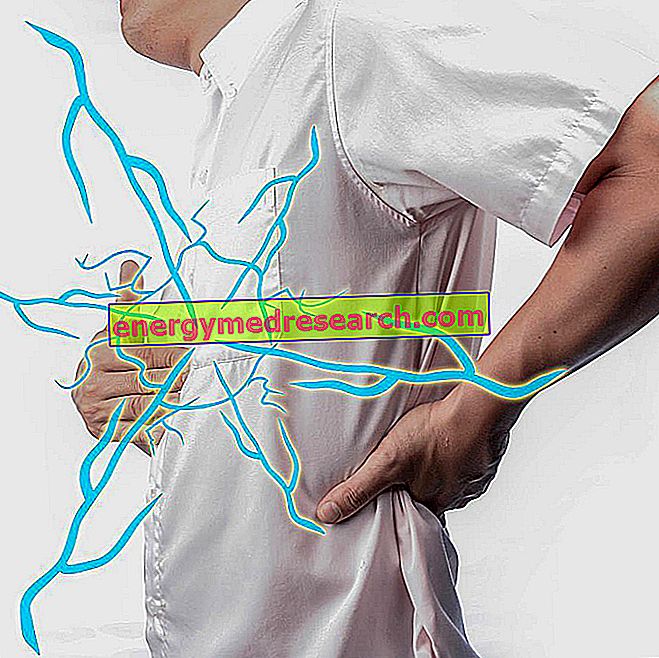Generality
Choking from inhalation of a foreign body is a pathological event characterized by difficulty or impossibility to breathe .

This type of accident can occur due to the ingestion or inhalation of foreign bodies, such as small objects or food, which obstruct the airways in a partial or complete manner. The suffocation causes anoxia, that is an interruption of the oxygen supply to the organs and tissues, therefore the absence of a timely intervention can lead to loss of consciousness and cardiac arrest .
The alarm signals that can lead to the suspicion of inhaling a foreign body include forced inhalation and " air hunger " in an attempt to escape the impediment of breathing, agitation and cyanosis in the face. These manifestations arise quickly and must prompt the rescuer to perform a sudden operation with maneuvers that can save the suffocation victim's life.
What's this
What is meant by Inhalation Suffocation from Foreign Body?
Choking is an impediment to respiratory mechanics, often a consequence of large pieces of food, candy or small objects, which can be swallowed or inhaled easily whole. In a few seconds, this results in airway obstruction .
Suffocation from inhalation of a foreign body is a clinical emergency and constitutes one of the main causes of accidental death in childhood (especially in children under the age of 3 years), in the home or in schools. If the inhaled object is wedged into the larynx or trachea and is large enough to cause almost complete obstruction of the airway, in fact, asphyxia can occur within a few minutes and lead to the death of the suffocation victim.
Causes and Risk Factors
Foreign Body Inhalation Suffocation: Why Does It Occur?
The suffocation from inhalation of a foreign body is an accidental and potentially fatal event, characterized by the passage of a foreign body in the respiratory tract.
This type of accident is possible at any age, but is more frequent among infants up to 12 months of life and in children between 1 and 4 years old . In pediatric age, the risk of suffocation is correlated to the incomplete maturity of the reflexive coordination mechanisms and to the reduced diameter of their airways. Choking from inhalation of a foreign body can result from simultaneous actions of the child, such as talking or laughing at mealtimes or during play.
Once inhaled or accidentally swallowed, large pieces of food or small objects can obstruct the airway either partially or completely .
Who is more at risk of foreign body inhalation suffocation
Choking from foreign body inhalation is a relatively frequent event in the age group between 6 months and 3 years. The accident can occur while children eat or play with small objects (eg peanuts, candy, coins or toy pieces); in fact, it is necessary to consider that, in the course of early childhood, the knowledge of the surrounding world initially passes through the mouth.
In pediatric age, the greater predisposition to suffocation is due to some typical characteristics of the psychophysical development and physiology of the respiratory tree, that is:
- Small diameter airways;
- Poor coordination between chewing and swallowing solid foods;
- Incomplete dentition;
- High respiratory rate;
- Tendency to perform multiple activities at the same time (for example, children eat while they run, play, talk or watch TV).
The danger of suffocation remains high up to 14 years of age.

Foreign body inhalation choking: dangerous objects and food
Usually, the inhaled object is a piece of food, but the spectrum of possibilities reported is very varied and includes:
- Pen stoppers;
- Bone fragments;
- Removable toys;
- Stacks and magnets;
- Teeth;
- Balls of all types and materials;
- Coins;
- Pendants and buttons.
As for food, the features to watch out for are:
- Size : both small foods that are difficult to manage during chewing (eg seeds, popcorn) and too large ones (eg large pieces of raw vegetables that risk ending up in the airways before they can be bitten) are dangerous;
- Shape : the washers (eg sliced carrots and frankfurters) or round foods (eg cherry tomatoes, cherries, grapes, peanuts, pistachios and hazelnuts) are particularly risky, as they can slip and get stuck in the hypopharynx;
- Consistency : attention must be paid to hard and fibrous foods (eg celery, fennel and greasy ham); sticky and soft foods can also be dangerous (eg marshmallows, large or rubbery candies, mozzarella balls and spreadable creams).
Symptoms and Complications
Foreign Body Inhalation Suffocation: How to Recognize It?
Choking occurs after the ingestion of a food or the inhalation of an object with a sudden respiratory crisis .
During the episode, besides being difficult, breathing typically produces a high- pitched noise . In addition, those who are suffocating may contract both hands on the throat and may cough or assume a bluish complexion ( cyanosis ). Furthermore, in case of suffocation, conjunctival and cutaneous petechiae, sweating, convulsions and fainting can occur .
The consequences of airway obstruction can be severe and can sometimes be fatal.
Choking: symptoms of airway obstruction
The rapid recognition of the signals associated with the suffocation from inhalation of foreign bodies and the correct execution of first aid maneuvers are of fundamental importance.
To intervene correctly, first of all, it is necessary to distinguish between two situations:
- Partial obstruction : the inhaled foreign body is of a significantly smaller caliber than that of the airways and goes to wedge itself at the bronchial level. The object is therefore in a position to allow a minimum passage of air, which is still sufficient to oxygenate the blood. The victim of suffocation from inhaling a foreign body is able to cough or cry;
- Complete obstruction : when wedged into the larynx or trachea, a sufficiently large foreign body creates a sort of "plug" in the airways that prevents the passage of air. Therefore, the person affected by choking from foreign body inhalation is no longer able to cough and is unable to emit any sound. This condition represents an emergency that deserves immediate intervention because, if it is not quickly resolved, it leads to asphyxia and death within a few minutes.
Warning!
In case of suffocation from inhalation of foreign body, the rescuer must understand when and how to intervene ; in order not to make the situation worse, it is important that the intervention maneuvers are carried out in the correct order, remembering that an improper intervention can aggravate a non-critical situation.
When you recognize the signs of suffocation in a person ( child or adult ), that is:
- He can't talk, cry or scream; if he can do it, bring your hands around your neck (defense reflex)
- The face becomes pale or bluish (cyanotic) due to the lack of oxygen (anoxia)
you must promptly intervene with the unblocking maneuvers to avoid the degeneration of the event.
In any case, it is important to alert the 118 and the victim must be assessed in the Emergency Department .
Diagnosis
Foreign Body Inhalation Suffocation: Diagnosis Exams
The diagnosis of suffocation from inhalation of a foreign body is based on anamnestic data, when present, of cough after food or other objects are introduced into the oral cavity .
The suspicion of suffocation from inhalation of a foreign body is confirmed in the hospital, by performing a chest x-ray, possibly followed by a CT scan . To visualize the precise location and position of the object, we resort to the fibroscopy of the airway, a method that, through a service channel, allows the introduction of the pincer for the removal of the wedged foreign body. Alternatively, a rigid bronchoscope is used.
Treatment
What NOT to do in case of foreign body inhalation suffocation
In case of suffocation, to avoid the passage of the inhaled foreign body from the alimentary ways to the respiratory ones:
- Do not shake the person who is suffocating;
- Do not induce vomiting;
- Do not attempt to remove the foreign body from the oral cavity.
Foreign Body Inhalation Suffocation: What to Do
In the case of partial obstruction of the airway, the victim of suffocation from inhaling a foreign body must be assisted and encouraged to cough vigorously and spontaneously, without any interference (note: the cough reflex indicates the presence of a passage, albeit minimal, of air). Exercising blows or slaps on the back or shoulders could aggravate the situation, as it can contribute to the displacement of the foreign body, risking to completely obstruct the passage of air. Therefore, if the person affected by the suffocation is conscious, he cries, can speak, coughs, nothing needs to be done.
If a complete obstruction of the airways occurs, the intervention of the rescuers is, instead, fundamental to save the life of the person who is suffocating.
How do you intervene?
The sequence of operations to be performed in case of suffocation varies according to the age of the patient .
In newborns and infants (up to 1 year of age), the airway unblocking maneuvers are performed. In practice, interscapular and chest compressions are alternated until the complete obstruction is resolved. If the child becomes unconscious, waiting for the paramedics, it is necessary to place the patient supine on a rigid plane and proceed with basic cardiopulmonary resuscitation .
Pediatric cleanup maneuvers (in summary)
PARTIAL OBSTRUCTION
How to recognize it
The child is able to cough, cry and talk.
What to do
- AVOID any unblocking maneuver;
- Calm the baby and encourage him to cough.
If the clinical picture does not resolve, call 118 or carry the child to the nearest emergency room.
COMPLETE OBSTRUCTION
How to recognize it
The child is NOT able to cough or cry or speak.
What to do
- Ask for help and have the emergency number activated with extreme urgency by calling 118.
- Immediately carry out pediatric unblocking maneuvers:
- 5 interscapular shots with a side escape route;
- 5 slow and deep chest compressions (in the middle of the sternum, using two fingers, in the infant; Heimlich maneuver in the child).
- Continue to alternate the maneuvers until the foreign body is expelled.
- If the child becomes unconscious:
- Place on a rigid surface;
- Remove the foreign body, only if surfacing;
- Ensure airway patency;
- Perform cardiopulmonary resuscitation (CPR).
In adults and older children (over 1 year of life), interscapular strokes (such as for the infant) are alternated with the Heimlich maneuver, up to the expulsion of the foreign body.
This airway clearance procedure is performed with the patient standing or sitting.
Heimlich maneuver (in summary)
The rescuer stands behind the victim, then wraps his waist with both arms. The hands are placed one above the other, closed in a fist, between the lower end of the sternum and the navel. Once this posture is taken, the rescuer performs vigorous compressions on the abdomen, which have a direction in the antero-posterior sense (that is, pushing the child towards him) and caudo-cranial (from the bottom upwards). The aim is to obtain an "artificial" cough, exploiting the residual air in the lungs.
The Heimlich maneuver must be continued until the complete obstruction is resolved or until the patient becomes unconscious (an event that requires cardiopulmonary resuscitation).
To learn more: Heimlich maneuver - When and how to do it »If the victim of suffocation from inhaling a foreign body becomes unconscious, it is important:
- Position the patient supine on a rigid surface;
- Perform the basic cardiopulmonary resuscitation, summarized as follows:
- In the absence of respiratory activity: perform 5 breaths (Mouth / Mouth-Nose in the infant; Mouth / Mouth in the child);
- If the signs of circulatory activity are not present: 30 chest compressions (technique of 2 fingers in the infant);
- Continue alternating 30 compressions with 2 ventilations for 3 cycles (about 1 minute).
Resuscitation maneuvers must continue until the vital signs reappear or help arrives (118).
Endoscopic removal of the foreign body
Foreign bodies that are not expelled or do not pass spontaneously into the stomach must be removed within 24 hours of the onset of suffocation symptoms.
Generally:
- Emergency endoscopic removal is necessary for sharp foreign bodies and for any obstruction responsible for suffocation with significant symptoms;
- If the obstruction of the respiratory tract is not severe and the object inhaled is not sharp or round, the patient remains in observation, waiting for the passage of the foreign body in the food bolus, which will be suggested by the disappearance of the symptoms. If this does not occur, endoscopic removal is performed.



